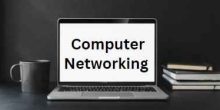Unit 1
Introduction to Data Communication Definition: Effectiveness, Basic Communication Components. Network Architecture Definition, History, Criteria, Goals and Applications of Networks, Categories of networks, Organization of the Internet, ISP, Protocols and standards, The OSI reference model, TCP/IP protocol suite, Network devices and components. Network topology design, Types of connections.
Q201 – Which connector STP uses?
BNC
RJ-11
RJ-45
RJ-79
Ans – (3)
Explanation – STP (Shielded Twisted Pair) cables typically use RJ-45 connector.
This is a standard connector used for Ethernet cables, including both UTP (Unshielded Twisted Pair) and STP (Shielded Twisted Pair) cables. The RJ-45 connector has 8 pins and is used to terminate twisted pair cables for connectivity in Ethernet networks.
Q202 – The receive equalizer reduces delay distortions using a ……………
Tapped delay lines
Gearshift
Descrambler
Difference engine
Ans – (1)
Explanation –
Tapped Delay Lines – In digital communication systems, a receive equalizer uses tapped delay lines to adjust the amplitude and phase of received signals.
Tapped delay lines consist of multiple delay elements (taps) with adjustable weights that help compensate for delay distortions caused by the transmission medium.
Q203 – To connect a computer with a device in the same room, you might be likely to use
A coaxial cable
ground station
A dedicated line
All of the above
Ans – (3)
Explanation –
Dedicated Line – This is the most appropriate option for connecting a computer directly to a device in the same room. A dedicated line refers to a direct, private connection between two points without sharing bandwidth with other users. It could be a physical cable (such as Ethernet cable) or a dedicated wireless link (like a Wi-Fi connection).
Coaxial Cable – Coaxial cables are typically used for cable television connections, broadband internet, and other specific applications, but they are not typically used for short-distance connections within the same room for general computer-to-device connections.
Ground Station – A ground station is a term used in satellite communications and is not relevant to connecting a computer with a device in the same room.
Q204 – Usually, it takes 10-bits to represent one character. How many characters can be transmitted at a speed of 1200 BPS?
12
120
1200
12000
Ans – (3)
Explanation –
To determine how many characters can be transmitted at a speed of 1200 BPS (Bytes Per Second), and considering it takes 10 bits to represent one character, we need to convert the speed from bytes to bits per second
Speed in bits per second = 1200 BPS × 10 bits/character = 12000 bits per second
Number of characters per second = Speed in bps / bits per character = 1200 characters per second.
Q205 – Carrier is
A continuous frequency capable of being modulated or impressed with a second signal
The condition when two or more sections attempt to use the same channel at the same time
One or more conductors that serve as a common connection for a related group of devices
A collection of interconnected functional units that provides a data communications service among stations attached to the network
Ans – (1)
Explanation –
A continuous frequency – This means it is a steady, ongoing signal at a specific frequency.
Capable of being modulated or impressed with a second signal – This means we can change (or modulate) this steady signal by adding another signal to it.
Q206 – A noiseless 3 KHz Channel transmits bits with binary level signals. What is the maximum data rate?
6 Kbps
12 Kbps
24 Kbps
48 Kbps
Ans – (1)
Explanation –
Maximum Data Rate = 2×3000×log2(2) = 6000 bps = 6 kbps
Q207 – If digital data rate of 9600 bps is encoded using 8-level phase shift keying (PSK) method, the modulation rate is
1200 bands
2800 bands
3200 bands
4400 bands
Ans – (3)
Explanation –
Data rate = 9600 bits per second (bps)
Each symbol represents 3 bits (due to 8-level PSK)
The modulation rate (or symbol rate) is calculated as
Modulation Rate = Data Rate / Bits per Symbol
Modulation Rate = 9600 bps / 3 bits per symbol
Modulation Rate = 3200 symbols per second (baud)
Q208 – What frequency range is used for FM radio transmission?
Very Low Frequency : 3 kHz to 30. kHz
Low Frequency : 30 kHz to 300 kHz
High Frequency : 3 MHz to 30 MHz
Very High Frequency : 30 MHz to 300 MHz
Ans – (4)
Explanation – FM radio transmission uses frequencies in the Very High Frequency (VHF) range. Specifically, FM radio is typically transmitted between 88 MHz and 108 MHz, which falls within the VHF range.
Q209 – If delays are recorded as 10 bit numbers in a 50 router network, and delay vectors are exchanged twice a second, how much bandwidth per fill duplex line is occupied by the distributed routing algorithm?
5 bps
500 bps
1000 bps
1500 bps
Ans – (3)
Explanation –
Delay bit by all router = 10*50 = 500 bit.
Here given delay vector are exchanged twice a second, it means one bit exchanged in 2 sec.
So, 500 bits will exchange in 500*2= 1000 bit.
Here notice that 500 bits cover by all router in only one second.
Hence 1000 bps
Q210 – Bandlimited signal is
Transmission of signals without modulation
Simultaneous transmission of data to a number of stations
A signal all of whose energy is contained within a finite frequency range
All of the above
Ans – (3)
Explanation –
A bandlimited signal is a signal whose energy is contained within a finite frequency range. This means that the signal does not have frequency components outside a specified range.
Q211 – After coding a document into a digital signal, it can be sent by telephone, telex or satellite to the receiver where the signal is decoded and an exact copy of the original document is made. What is it called?
Telex
Facsimile
Electronic mail
Word processor
Ans – (2)
Explanation –
Facsimile, often abbreviated as “fax,” involves the conversion of a document into a digital signal that can be transmitted via various means (telephone, telex, satellite).
At the receiving end, the digital signal is decoded and reproduced as an exact copy of the original document. This method has been historically used for transmitting documents over long distances quickly, before the widespread use of digital scanning and email became prevalent.
Q212 – A 6-MHz channel is used by a digital signalling system utilizing 4-level signals. What is the maximum possible transmission rate?
6 Mband/sec
12 Mband/sec
18 Mband/sec
24 Mband/sec
Ans – (2)
Explanation –
Bandwidth = 6 MHz
Number of signal levels = 4
Maximum transmission rate = 2*B*log2 (4)
Maximum transmission rate = 2 * 6000000 * 2 = 24 mbps.
The answer is in Mbaud per second, So, we will convert 24 mbps into Mbaud per sec.
If there are 4 levels in a signal, so there are 2 bits used for each signal level. Therefore, the baud rate is 24/2 Mbaud per second.
The answer is 12 Mbaud per sec.
Q213 – A 4 KHz noise less channel with one sample ever 125 per sec is used to transmit digital signals. Differential PCM with 4 bit relative signal value is used. Then how many bits per second are actually sent?
8 Kbps
16 Kbps
32 Kbps
64 Kbps
Ans – (3)
Explanation –
To determine how many bits per second are actually sent using Differential Pulse Code Modulation (DPCM) with a 4-bit relative signal value.
- Channel Bandwidth – 4 KHz (4000 Hz)
- Sampling Rate – One sample every 125 microseconds (µs)
- Bits per Sample – 4 bits
Sampling Rate=1/125×10−6 seconds = 8000 samples per second
Now, given that each sample in DPCM is encoded with 4 bits
Bits per second = Sampling Rate × Bits per Sample
Bits per second = 8000 × 4 = 32000 bps = 32 kbps
Q214 – Baseband is
A signal all of whose energy is contained within a finite frequency range
The simultaneous transmission of data to a number of stations
Transmission of signals without modulation
All of the above
Ans – (3)
Explanation –
Baseband refers specifically to signals that are transmitted without modulation, meaning the signal occupies the lowest possible frequency range and all its energy is contained within a finite frequency range. This term is often used in contrast to broadband or modulated signals, which are shifted to higher frequency ranges for transmission.
Q215 – Which of the following frequency ranges is used for AM radio transmission?
High Frequency : 3 MHz to 30 MHz
Very Low Frequency : 3 kHz to 30 kHz
Medium Frequency : 300 kHz to 3 MHz
Very High Frequency : 30 MHz to 300 MHz
Ans – (3)
Explanation –
The frequency range used for AM (Amplitude Modulation) radio transmission is Medium Frequency : 300 kHz to 3 MHz
Q216 – Phase shift keying (psk) method is used to modulate digital signals at 9600 bps using 16 levels. Find the line signalling speed (i.e., modulation rate)
1200 bands
2400 bands
3600 bands
4800 bands
Ans – (2)
Explanation – To determine the line signaling speed (modulation rate) when using Phase Shift Keying (PSK) with 16 levels to modulate digital signals at 9600 bps, we need to calculate how many bits each symbol represents and then find the symbol rate.
Number of levels = 16 levels
Number of bits per symbol = log2 (16) = 4 bits
Modulation Rate = Data Rate / Bits per symbol
Modulation Rate = 9600 / 4 = 2400 bands
Q217 – A 2000-character text file has to be transmitted by using a 1,200 baud modem. Can you tell how long will it take?
10 seconds
20 seconds
120 seconds
200 seconds
Ans – (2)
Explanation –
One character is equal to eight bits.
One bit/second is equal to one Baud.
A frame = Start Bit + Data Bit + Parity Bit + Stop Bit = 1+8+1+2=12 bit.
Transmission Time = 12*2000/1200 = 20 Seconds.
Q218 – A no periodic signal has changed to a periodic signal with the period equal to
2 times the bit duration
4 times the bit duration
8 times the bit duration
12 times the bit duration
Ans – (1)
Explanation – A
When a non-periodic signal is converted into a periodic signal through modulation, particularly in digital communications, the period of the resulting signal often relates to the timing or duration of the digital bits being transmitted.
This means that if the bit duration is T, then the period of the resulting periodic signal after modulation would typically be 2T.
Q219 – The bit rate for 1000 baud, FSK, baud rate would be
1000 bps
1500 bps
2000 bps
100 bps
Ans – (1)
Explanation –
Bit rate = Baud rate × Number of bits per symbol
Baud rate = 1000 baud
FSK is used, which typically has 1 bit per symbol
Therefore, Bit rate = 1000 × 1
Bit rate = 1000 bps
Q220 – A system is using NRZ-I to transfer 10-Mbps data. What would be minimum bandwidth
500 kHz.
1000 KHz
2000 KHz
5000 KHz
Ans – (1)
Explanation –
Average signal rate is S = N/2 = 500 kbaud. The minimum bandwidth for this average baud rate is Bmin = S = 500kHz.



